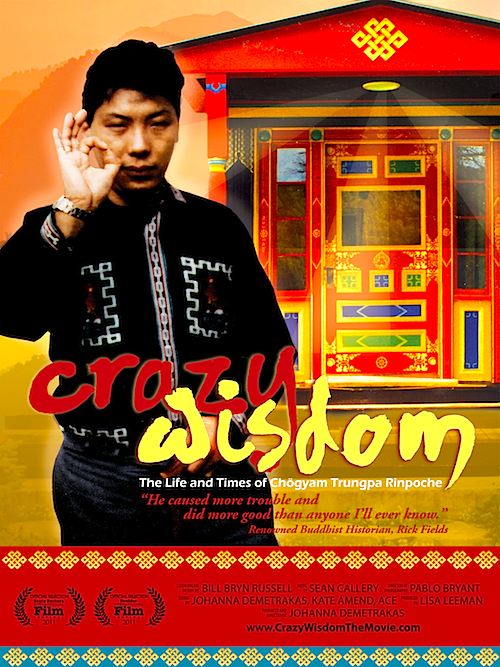By Joe Bendel. Chogyam Trungpa, Rinpoche was a Tibetan Buddhist teacher who embraced the 1960’s counterculture, but could not abide rock & roll. He drank significantly more than he should have, openly and often, but he had no use for drugs. A former monk, Trungpa renounced his robes, developing ways to teach Tibetan Buddhism in the western vernacular. A study in paradoxes, Trungpa’s all too brief life avoided cliché, making him a rich documentary subject in Johanna Demetrakas’ Crazy Wisdom: the Life and Times of Chogyam Trungpa, Rinpoche, which opens this Friday in New York at the Rubin Museum of Art.
 A recognized reincarnation, Trungpa was the last of his generation to be entirely educated in Tibet. After the Chinese Communists invaded in 1959, he took a leading role securing the teachings and documents of his faith, personally guiding a group of his fellow monks to safety in India. Living in exile, Trungpa chose to embrace the west, trading his robes for a business suit. It was the start of a transformation that was decidedly controversial with his elders.
A recognized reincarnation, Trungpa was the last of his generation to be entirely educated in Tibet. After the Chinese Communists invaded in 1959, he took a leading role securing the teachings and documents of his faith, personally guiding a group of his fellow monks to safety in India. Living in exile, Trungpa chose to embrace the west, trading his robes for a business suit. It was the start of a transformation that was decidedly controversial with his elders.
Living in Scotland, Trungpa married a young British woman and began teaching Tibetan Buddhism to hippies. For obvious reasons, they were attracted to his “crazy wisdom,” a recognized approach to enlightenment celebrating the eccentric and unconventional, sort of the rough Tibetan Buddhist analog to drunken master martial arts. However, Trungpa liked to keep people guessing.
As one of his students recalls, at the height of the anti-war movement, Trungpa was once asked to comment about aggression in America, to which he replied: “I want to talk about the aggression in this room.” Ouch. He was also evidently a stickler for the Queen’s English, perhaps giving scores of hippies their first elocution lessons. However, the greatest irony must have been the Dorje Kasung, the military drill team he established at Naropa University, the American Buddhist school Trungpa founded in Boulder, Colorado.
Clearly, the Ripoche was more responsible than anyone for creating a network of schools and support centers for Tibetan Buddhism, through direct action and the subsequent contributions of his students. Still, he is a devilishly difficult figure to grab hold of. In fact, his wife, Diana Mukpo, readily admits on-camera the inner Trungpa largely remains a mystery to her. He clearly touched a lot of lives, but it is just as obvious he rarely denied himself a good time. With many students-turned-lovers sharing their reminiscences, it is evident he enjoyed the company of women and a good drink. This complicates the beatification process, but it makes for fascinating viewing.
Frankly, the audience will not feel like they know the Rinpoche any better than Mukpo. He led a short but eventful life, emerging as an intriguing Rorschach for those around him. Featuring better than average graphics and revealing interviews with intimates like Mukpo and his first son, Sakyong Mipham, Rinpoche, the head of Shambhala International, as well “celebrity” admirers such as Allen Ginsburg and Ram Dass, Crazy covers the traditional documentary bases quite well. Yet, it best lives up to Trungpa’s example by constantly confounding viewer expectations of who and what the Rinpoche should have been. A surprisingly challenging documentary profile (considerably superior to Jennifer Fox’s thematically related My Reincarnation), Crazy is definitely recommended when it fittingly opens this Friday (11/25) at the Rubin Museum of Art, New York’s home for Himalayan art and culture (not to mention fine jazz and film programming).
Posted on November 23rd, 2011 at 11:32am.
I know someone who goes to that school. I’ll forward this to him.